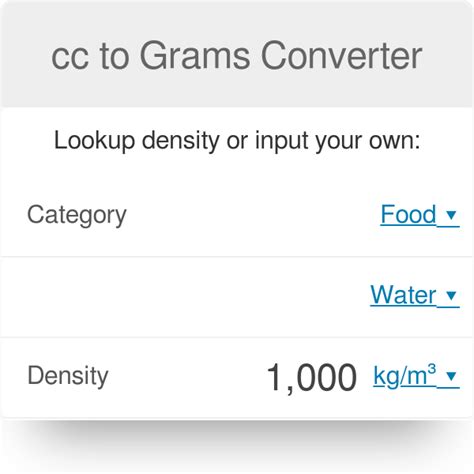How Many Cc Is In A Gram
Arias News
Apr 01, 2025 · 4 min read

Table of Contents
How Many CCs are in a Gram? Understanding Volume and Mass
The question "How many cc's are in a gram?" doesn't have a straightforward answer. It's a common misconception that there's a direct conversion between cubic centimeters (cc) and grams. This is because cc (or mL) measures volume, while grams measure mass. To relate them, you need to know the density of the substance you're dealing with. Density is the mass per unit volume, typically expressed as grams per cubic centimeter (g/cc) or grams per milliliter (g/mL).
Understanding the Difference Between Volume and Mass
Before diving into the calculations, let's clarify the fundamental difference between volume and mass:
-
Volume: This refers to the amount of three-dimensional space a substance occupies. Think of it as how much space something takes up. Common units of volume include cubic centimeters (cc or cm³), milliliters (mL), and liters (L). 1 cc is equivalent to 1 mL.
-
Mass: This refers to the amount of matter in a substance. It's essentially how much "stuff" is present. The common unit of mass is the gram (g). Mass is often confused with weight, but they are distinct. Weight is the force of gravity acting on mass.
The Role of Density in the Conversion
The relationship between volume (in cc or mL) and mass (in grams) is governed by the density of the substance:
Density = Mass / Volume
This means:
- Mass = Density x Volume
- Volume = Mass / Density
To find the number of cc's (or mL) in a gram, you need to rearrange the formula to solve for Volume:
Volume (in cc or mL) = Mass (in grams) / Density (in g/cc or g/mL)
Density of Common Substances
The density of different substances varies greatly. Here's a table illustrating the densities of some common materials:
| Substance | Density (g/cc or g/mL) |
|---|---|
| Water (at 4°C) | 1.00 |
| Ice | 0.92 |
| Aluminum | 2.70 |
| Iron | 7.87 |
| Gold | 19.32 |
| Air (at sea level) | 0.0012 |
| Gasoline | ~0.75 |
Examples: Calculating Volume from Mass
Let's work through some examples to illustrate the calculation:
Example 1: Water
Let's say we have 10 grams of water. Since the density of water is approximately 1 g/cc, the calculation is straightforward:
Volume = Mass / Density = 10 g / 1 g/cc = 10 cc
Therefore, 10 grams of water occupy a volume of 10 cubic centimeters (or 10 milliliters).
Example 2: Aluminum
Now let's consider 10 grams of aluminum. The density of aluminum is approximately 2.7 g/cc. The calculation becomes:
Volume = Mass / Density = 10 g / 2.7 g/cc ≈ 3.7 cc
So, 10 grams of aluminum occupy a volume of approximately 3.7 cubic centimeters.
Example 3: Gold
Finally, let's calculate the volume of 10 grams of gold. Gold has a density of approximately 19.32 g/cc:
Volume = Mass / Density = 10 g / 19.32 g/cc ≈ 0.52 cc
Thus, 10 grams of gold occupies a volume of approximately 0.52 cubic centimeters.
The Importance of Specifying the Substance
As these examples demonstrate, the volume occupied by a given mass depends entirely on the substance's density. You cannot answer "how many cc's are in a gram" without knowing the material. The answer will change drastically depending on whether you are dealing with water, aluminum, gold, or any other substance.
Beyond Simple Calculations: Factors Affecting Density
While the density of a substance is often considered a constant, several factors can influence it:
-
Temperature: Density usually changes with temperature. Substances generally expand when heated, resulting in a decrease in density. This is why the density of water is specified at 4°C (its point of maximum density).
-
Pressure: Pressure also affects density. Increasing the pressure on a substance generally increases its density.
-
Phase: The density of a substance varies dramatically depending on its phase (solid, liquid, or gas). Ice, for instance, is less dense than liquid water.
-
Composition: For mixtures and solutions, the density depends on the proportions of the components.
Practical Applications
Understanding the relationship between mass, volume, and density has numerous practical applications across various fields:
-
Chemistry: Density is crucial in stoichiometric calculations and determining the concentration of solutions.
-
Physics: Density plays a vital role in fluid mechanics, determining buoyancy and the behavior of fluids under different conditions.
-
Engineering: Density is a critical parameter in material selection for various engineering applications, considering factors like strength, weight, and cost.
-
Geology: Rock density is an essential factor in geological surveys and resource exploration.
Conclusion: No Universal Conversion
There's no single answer to the question "How many cc's are in a gram?" because the conversion depends entirely on the density of the substance involved. Always remember to consider the density when converting between mass and volume. This understanding is fundamental in various scientific and engineering disciplines. Accurately calculating volume from mass necessitates knowing the density of the specific material in question. Remember that the relationship is defined by the equation: Volume = Mass / Density.
Latest Posts
Latest Posts
-
How Many Basketball Courts Fit On A Football Field
Apr 02, 2025
-
Wayne Brady Salary On Lets Make A Deal
Apr 02, 2025
-
What Was Martin Luther King Jr Favorite Color
Apr 02, 2025
-
How Do You Say Hello In Swahili Language
Apr 02, 2025
-
How Much Is 55 Grams Of Sugar
Apr 02, 2025
Related Post
Thank you for visiting our website which covers about How Many Cc Is In A Gram . We hope the information provided has been useful to you. Feel free to contact us if you have any questions or need further assistance. See you next time and don't miss to bookmark.
